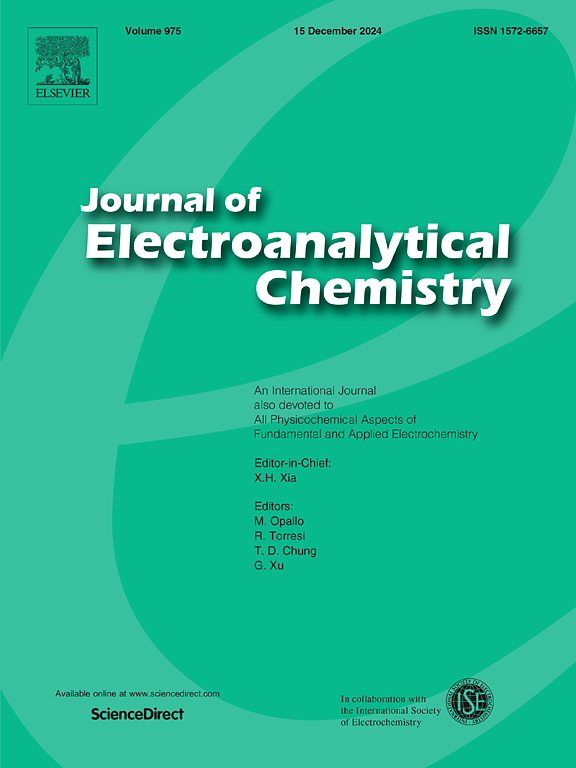基于电化学合成2h -二硫化钼/氯掺杂氧化石墨烯(2H-MoS 2 /Cl-GO)复合电极的高性能无粘结剂超级电容器
IF 4.1
3区 化学
Q1 CHEMISTRY, ANALYTICAL
引用次数: 0
摘要
本文研究了二硫化钼(MoS 2)和氯掺杂氧化石墨烯(Cl-GO)复合材料作为超级电容器先进材料的合成和表征。通过电化学方法在室温下制备了无粘结剂电极,标志着2H-MoS 2 @Cl-GO材料在储能应用中的开创性应用。采用循环伏安法(CV)测定MoS₂,计时伏安法(CA)测定Cl-GO。综合表征,包括拉曼光谱、x射线光电子能谱(XPS)和x射线衍射(XRD),阐明了材料的化学结构。场发射扫描电镜(FESEM)结合能量色散x射线能谱(EDS)揭示了材料的表面形貌和元素组成。通过循环伏安法、电化学阻抗谱(EIS)和循环充放电测试对其电化学性能进行评价,表明其具有良好的电容性。2H-MoS 2 @Cl-GO电极的比电容为915.6 mF。在相同的条件下(0.25 mA),其性能优于Cl-GO电极(414.4 μ m .cm−2)。cm−2 (1.0 M H₂SO₄电解质)。值得注意的是,在5000次充放电循环后,电极保持了超过90.2%的容量,表明了出色的循环稳定性。该研究强调了2H-MoS 2 @Cl-GO复合材料作为高性能超级电容器高效耐用电极材料的潜力,为其在储能技术中的实际应用提供了有价值的见解。本文章由计算机程序翻译,如有差异,请以英文原文为准。

High-performance binder-free supercapacitors based on electrochemically synthesized 2H-molybdenum disulfide/chlorine-doped graphene oxide (2H-MoS₂/Cl-GO) composite electrodes
This research investigates the synthesis and characterization of molybdenum disulfide (MoS₂) and chlorine-doped graphene oxide (Cl-GO) composites as advanced materials for supercapacitors. Binder-free electrodes were prepared by an electrochemical method at room temperature, marking the pioneering use of 2H-MoS₂@Cl-GO materials in energy storage applications. The synthesis employed cyclic voltammetry (CV) for MoS₂ and chronoamperometry (CA) for Cl-GO. Comprehensive characterization, including Raman spectroscopy, X-ray photoelectron spectroscopy (XPS) and X-ray diffraction (XRD), elucidated the chemical structures of the materials. Field emission scanning electron microscopy (FESEM) combined with energy dispersive X-ray spectroscopy (EDS) revealed detailed surface morphology and elemental composition. Electrochemical performance evaluation by cyclic voltammetry, electrochemical impedance spectroscopy (EIS) and cyclic charge/discharge tests indicated promising capacitive behavior. The 2H-MoS₂@Cl-GO electrode exhibited a specific capacitance of 915.6 mF.cm−2, outperforming the Cl-GO electrode (414.4 mF.cm−2) under similar conditions (0.25 mA.cm−2 in 1.0 M H₂SO₄ electrolyte). Notably, the electrode retained over 90.2 % of its capacity after 5000 charge-discharge cycles, indicating excellent cycling stability. This study highlights the potential of 2H-MoS₂@Cl-GO composites as efficient and durable electrode materials for high performance supercapacitors, providing valuable insights for their practical application in energy storage technologies.
求助全文
通过发布文献求助,成功后即可免费获取论文全文。
去求助
来源期刊
CiteScore
7.80
自引率
6.70%
发文量
912
审稿时长
2.4 months
期刊介绍:
The Journal of Electroanalytical Chemistry is the foremost international journal devoted to the interdisciplinary subject of electrochemistry in all its aspects, theoretical as well as applied.
Electrochemistry is a wide ranging area that is in a state of continuous evolution. Rather than compiling a long list of topics covered by the Journal, the editors would like to draw particular attention to the key issues of novelty, topicality and quality. Papers should present new and interesting electrochemical science in a way that is accessible to the reader. The presentation and discussion should be at a level that is consistent with the international status of the Journal. Reports describing the application of well-established techniques to problems that are essentially technical will not be accepted. Similarly, papers that report observations but fail to provide adequate interpretation will be rejected by the Editors. Papers dealing with technical electrochemistry should be submitted to other specialist journals unless the authors can show that their work provides substantially new insights into electrochemical processes.

 求助内容:
求助内容: 应助结果提醒方式:
应助结果提醒方式:


